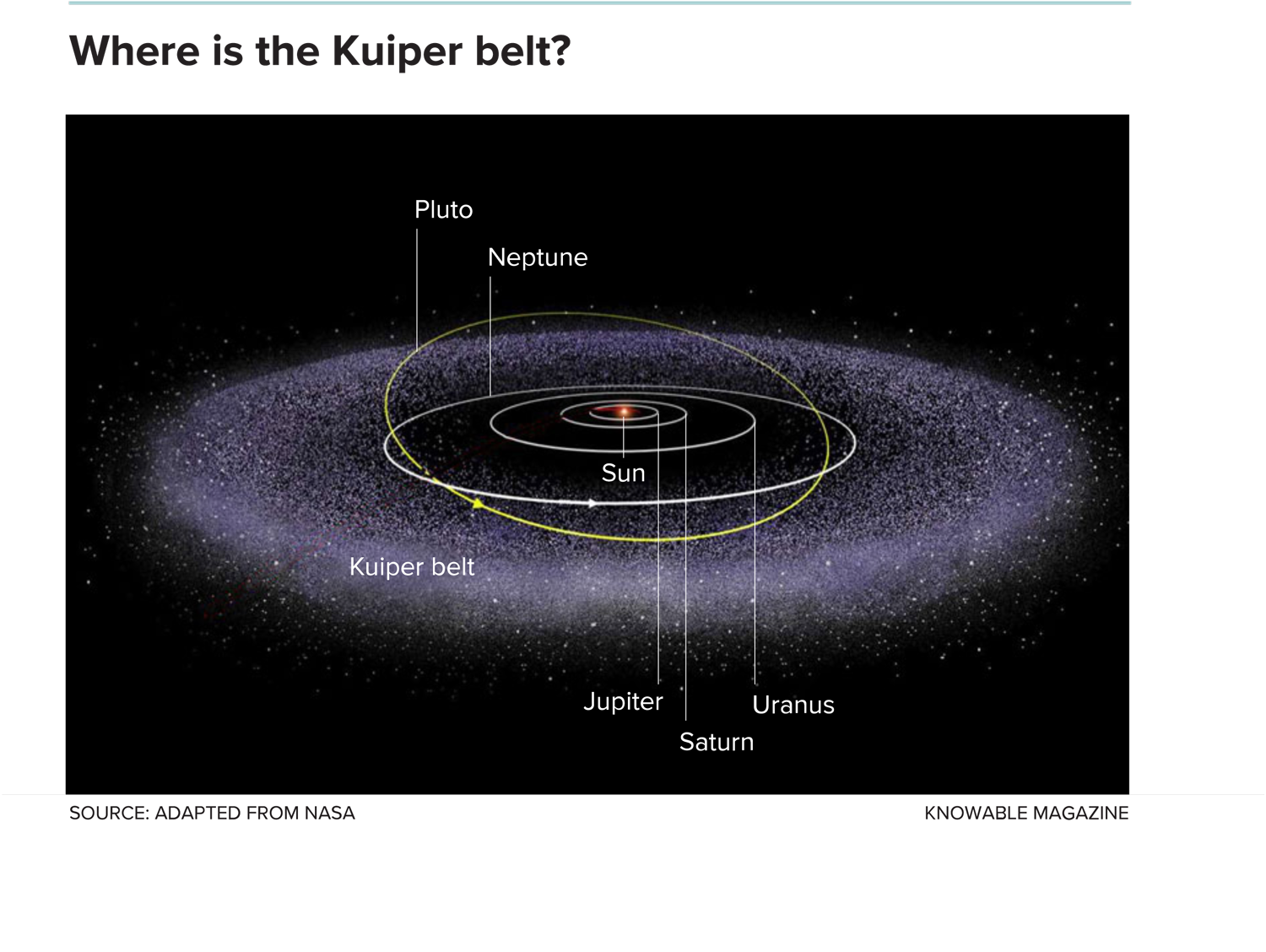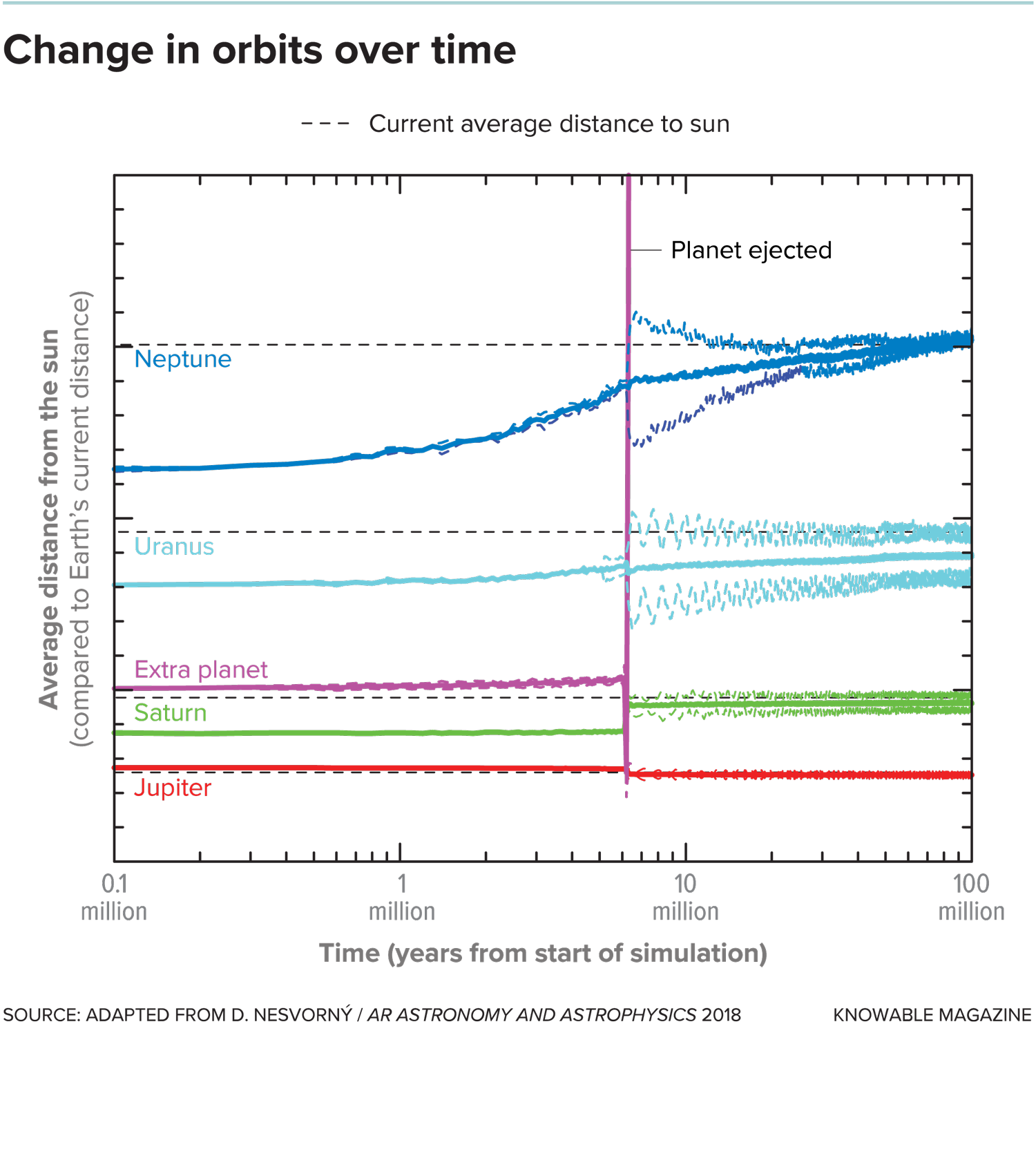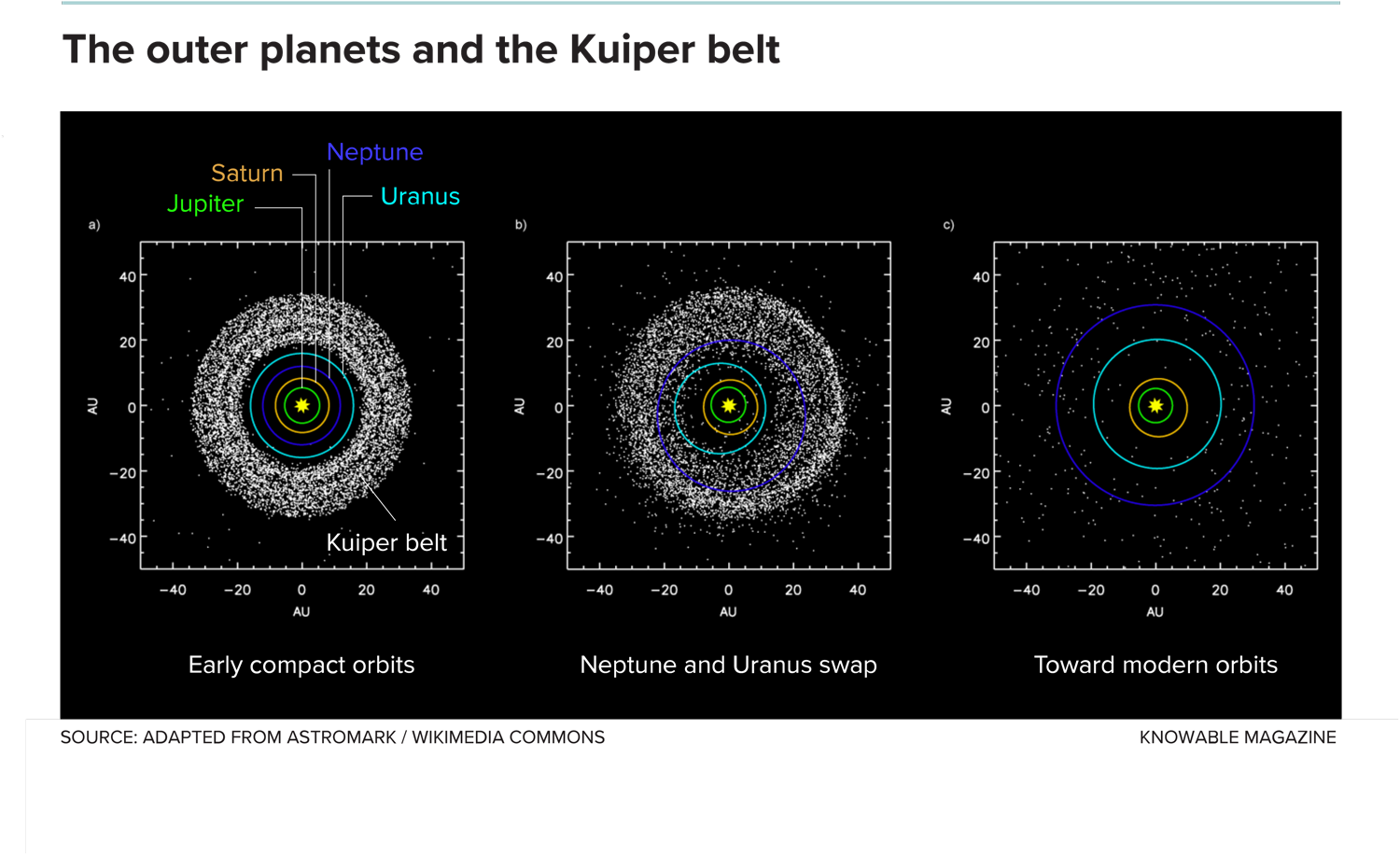Our solar system is like a 4.6-billion-year-old crime scene.
Crater-ridden surfaces, misaligned planetary orbits and streams of interplanetary debris are the cosmic equivalents of blood spatters on the wall and skid marks from a getaway car. These and other clues tell of a chaotic beginning for our planetary family.
Buried in those clues are hints of a lost sibling: a ninth planet (no, not Pluto) that was kicked away in a gravitational tug-of-war that reshaped the early solar system.
Today, the outer solar system is dominated by four giant worlds: Jupiter, Saturn, Uranus and Neptune. Beyond them lies the Kuiper belt, a field of icy debris that counts Pluto among its residents.

“We shouldn’t fall into the trap of looking at the outer solar system and thinking it was always like that,” says David Nesvorný, a planetary scientist at the Southwest Research Institute in Boulder, Colorado, who first made the case for a runaway planet in 2011.
Nesvorný is one of a cadre of scientists trying to figure out how the solar system evolved in its first few hundred million years. Using complex computer simulations, researchers had assembled a narrative in which the infant planets formed relatively close together and then jockeyed for position, alternately gliding and leaping from one orbit to another. Those simulations explained many of the minute details about how the planets, asteroids and comets orbit the sun today.
Except there was one problem. The story usually ended with either Uranus or Neptune getting kicked out of the solar system, Nesvorný writes in September in the Annual Review of Astronomy and Astrophysics.
Since Uranus and Neptune are quite clearly still present—spacecraft have visited both worlds, after all—that tale didn’t quite hold together. But a fifth giant planet, many researchers suspect, could be the hero that this mystery needs, and a critical missing player in the history of the solar system.
A phantom planet
To re-create these ancient scenes, astronomers rely on computer simulations to generate thousands of different solar systems in thousands of different ways. In lines of code, they lay out the laws of physics and the starting lineup of any planetary arrangement they can imagine. The researcher sets the stage—drop a planet here, sprinkle some asteroids there—then steps back and lets simulated nature take its course. After a couple of weeks in the real world—in which millions of years play out in the simulation—the astronomer peeks inside to see how the solar system turned out. The closer it is to the real thing, the better.
This is what Nesvorný was doing in 2009. He was playing around with virtual solar systems, trying to figure out a way to save virtual Uranus and virtual Neptune from a one-way trip into virtual deep space.
The problem was Jupiter. The giant planet is a bully, whose gravity can reach far and wide to push around smaller worlds and assorted debris. In the most successful simulations of the time, Jupiter and one of the two outermost planets ricocheted off each other and eventually settled into their modern orbits. But that only occurred about one percent of the time. In the other 99 percent of cases, Jupiter flung Uranus or Neptune so hard that they left the solar system, never to return.
“That makes things weird, because we know Uranus and Neptune survived,” Nesvorný says. So he kept tinkering. After a year of trying countless different scenarios, he started playing with the idea of adding martyr worlds: extra planets sacrificed to save the others.
“I would run these simulations just to see what would happen, not taking them too seriously,” Nesvorný says. “But then I realized there might be some truth in them.” He ran roughly 10,000 simulations, changing the number of extra planets, their starting locations and their masses in each one.
The best scenario—the one that reproduced a solar system that most closely resembles the real one—was one with an extra planet that lived between the original orbits of Saturn and Uranus. The world was roughly as massive as Uranus and Neptune, or about 16 times as massive as Earth. It was this planet that could have gotten tangled with Jupiter’s orbit and been tossed out of the solar system.

The odds still aren’t great. Repeated simulations of this setup worked only about five percent of the time. “The present solar system is neither a typical nor expected result,” Nesvorný wrote in a 2012 paper exploring the idea, cowritten by his colleague Alessandro Morbidelli of the Observatory of the Côte d’Azur in France. But it was a significant improvement over the one-percent success rate of simulations that included only the four giant planets we know and love today.
“Invoking the existence of a fifth [giant] planet is actually much simpler than not,” says Sean Raymond, a planetary scientist at the University of Bordeaux in France. While the evidence is largely circumstantial, “it makes a lot more sense to have had an extra one back then.”
That may seem like a stretch. How can astronomers know anything about what happened more than 4 billion years ago with the planets that we do have, much less ones that aren’t even here? Turns out, the planets left behind plenty of battle scars from their youth for planetary detectives to try to interpret.
Interplanetary blood splatters
“We are very certain that the planets didn’t form where they are today,” says Nathan Kaib, a planetary scientist at the University of Oklahoma in Norman.
This realization was quite recent, though. For most of history, stargazers assumed that the planets had always followed their existing orbits. But in the early 1990s, researchers realized that something was amiss in this scenario.
Just past the orbit of Neptune lies the Kuiper belt, a splash of icy debris encircling the sun. “They are the blood splatters on the wall,” says California Institute of Technology planetary scientist Konstantin Batygin.
The arrangement of the Kuiper belt objects led researchers to an inescapable conclusion: Neptune had to have formed closer to the sun than it is today. Many of the objects in the Kuiper belt clump together in concentric orbits, vaguely resembling the grooves in a record. And these aren’t just random orbits—they are linked directly to Neptune’s.
Take Pluto, the Kuiper belt’s most famous resident. It and a couple hundred of its known companions go around the sun exactly twice for every three trips that Neptune makes. Other streams of Kuiper objects go around once for every two of Neptune’s revolutions, or four for every seven.
There’s no way for the Kuiper belt to end up that way on its own. If, however, Neptune formed closer to the sun and then moseyed outward, its gravity would have acted like a net, trapping nearby interplanetary debris in these special orbits and bringing it along for the ride.

This matched what some simulations hinted at the decade before. Planet formation was a messy business that left debris scattered all over the solar system. Any fragments that came too close to Neptune would have been steered by the planet’s gravity. Since every action has an equal and opposite reaction, each time Neptune nudged a fragment, the planet would have been pushed in the opposite direction. Over time Neptune would have crawled slowly away from the sun.
Neptune’s migration implicates the other giant planets as well. After all, Jupiter, Saturn and Uranus were plowing through the same field of debris and dealing with similar gravitational interactions. If Neptune moved, then all the giant planets had to have moved.
And it couldn’t have been a smooth ride.
The incessant grind from all this debris should have sculpted the orbits of the giant planets into perfect, aligned circles, much the way clay on a potter’s wheel is smoothed out by the potter’s steady hand. That’s not how the orbits ended up, though. The giant planets instead travel on orbits that are slightly elongated and askew. It’s as if someone bumped into the wheel, deforming the once-round pots.
Jumping Jupiter
By 2005, researchers had uncovered a culprit. New simulations indicated that at some point the giant planets must have undergone what scientists call a “dynamical instability.” In other words, things got crazy for about a million years. The most likely source seemed to be a series of close encounters between Saturn and either Uranus or Neptune—a.k.a. the ice giants—which sent one of these two worlds toward Jupiter. As the wayward world approached, its gravity pulled back on Jupiter, slowing down the giant planet and dropping it to a lower orbit. But Jupiter pulled on the encroaching planet just as hard. The ice giant, being much lighter, sped up far more than Jupiter slowed down, redirecting it away from the sun.
This altercation was like a gravitational wallop to the solar system. Jupiter jumped inward while the rest of the outer planets leaped outward. This kick would have contorted the orbits of the giant planets into their modern poses. It also would have saved the inner solar system—Mercury, Venus, Earth, Mars and the asteroid belt—from being messed up by prolonged gravitational meddling from both Jupiter and Saturn, another problem that had arisen in earlier simulations.
Which brings us to the removal of Uranus or Neptune. It’s at this point in the simulations that Jupiter, more often than not, drop-kicks an ice giant out into the galaxy.
This is the dilemma that Nesvorný was trying to solve without breaking everything else about the simulations that did work. An extra ice giant takes the brunt of Jupiter’s bullying while letting the other events in the narrative unfold unimpeded.
“It’s completely plausible,” says Batygin. “[If you] ask is there any reason why we should have two instead of three ice giants, the answer is absolutely not.” In fact, he says, some calculations indicate that as many as five Neptune-like worlds could have formed initially.
Batygin and colleagues were exploring this question at the same time as Nesvorný, though their motives were different. “I wanted to demonstrate that there could not have been an extra giant planet,” he says.
He reasoned that this supposed planet, on its way out of the solar system, would have messed up a part of the Kuiper belt known as the cold classical belt. If the Kuiper belt were a donut, Batygin says, the cold classical belt would be the chocolate filling—a family of objects whose orbits lie nearly flat within the Kuiper belt. A passing planet should have stirred up those orbits, or so Batygin and colleagues thought.
Their computer simulations showed that it did no such thing. To their surprise, an ejected planet would not have destroyed the cold classical belt. It doesn’t prove the planet existed, just that the solar system works whether it was there or not. Could this planet have left a more direct signature? Or back to the crime scene analogy, are there any skid marks? Nesvorný thinks there might be.
A kernel of a clue
There is another part of the Kuiper belt called the kernel, a narrow stream of icy fragments whose orbits are not currently synced to Neptune’s. Its origin is a bit of a mystery. In 2015, Nesvorný argued that a jump in Neptune’s outward migration—caused by an ejected planet—could be responsible.
As Neptune trekked to its final orbit and swept up debris into orbits synced to its own, a “bump” at the right time could have released some of that debris, leaving it to become an independent stream, like the kernel. Simulations showed that the gravitational kick that made Jupiter jump and tossed out the extra planet would have happened at the right time to whack Neptune as well.
“You end up with something like the kernel,” Nesvorný says. “It’s circumstantial evidence … but it’s not conclusive.”
The truth is, we may never know exactly what went down in the solar system’s formative years. “We can’t write a solar system bible,” Batygin says. “We can only give a very murky story.”
If the solar system did kick out one of its own, it’s in good company. In recent years, astronomers have found a handful of rogue planets adrift between the stars, most likely ejected from their homes. With some extrapolation, “these observations show that there are more free-floating, Jupiter-sized planets in the galaxy than there are stars,” Nesvorný says.
That might be an overstatement—recent estimates put the number at closer to one rogue Jupiter for every four stars—but that’s still billions of wandering worlds. And those are just the ones as large as Jupiter. Our rogue was likely smaller, about the size of Neptune, and we have no idea how many of those are roaming the galaxy. But we do know that the universe tends to favor small things over large things.
“I bet there will be many,” Nesvorný says. Plus astronomers have discovered thousands of planetary systems in the Milky Way, and many of them show signs of dustups far more dramatic than our own. “It’s surprising,” he says, “how organized the solar system has remained.”
This article was originally published on October 3, 2018 by Knowable Magazine, an independent journalistic endeavor from Annual Reviews, and is reprinted with permission. Sign up for the newsletter.
AUTHOR: Christopher Crockett
Christopher Crockett is an astronomer-turned-science-journalist living in Arlington, Virginia.

